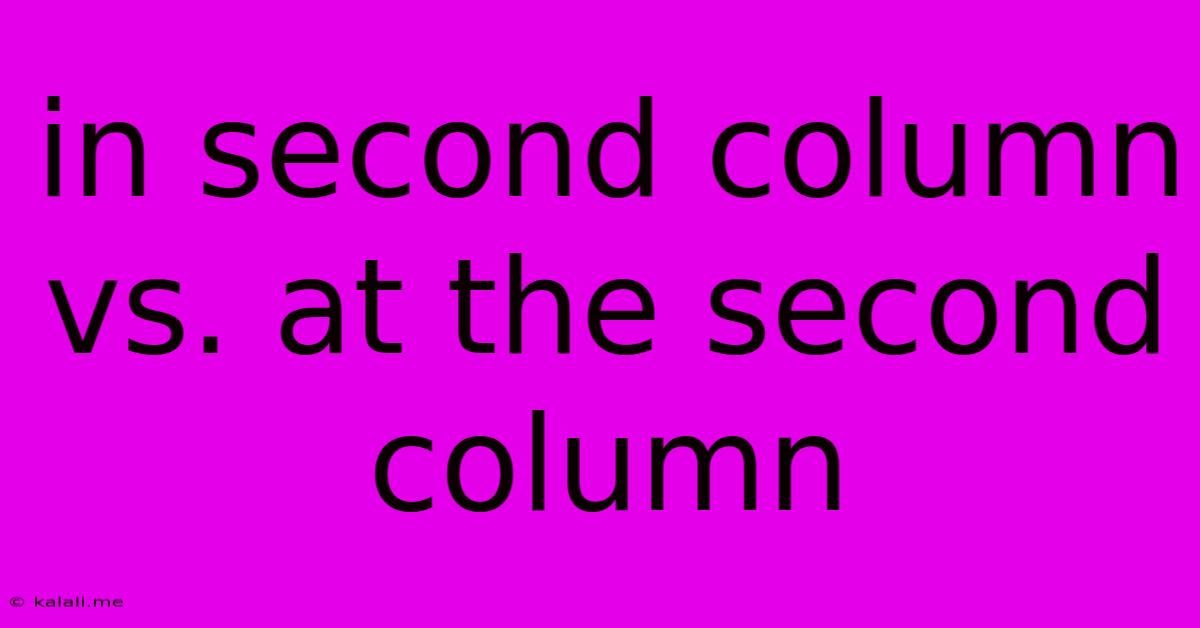In Second Column Vs. At The Second Column
Kalali
Jun 08, 2025 · 3 min read

Table of Contents
In Second Column vs. At the Second Column: A Grammatical Deep Dive
Choosing between "in the second column" and "at the second column" often leaves writers scratching their heads. While both prepositions might seem interchangeable at first glance, understanding their subtle nuances is crucial for clear and precise writing. This article will delve into the grammatical differences, providing examples to illuminate the appropriate usage of each phrase. This will help you choose the correct preposition and elevate your writing's precision.
Understanding the Prepositions: "In" and "At"
The prepositions "in" and "at" indicate location, but they convey different types of spatial relationships. "In" suggests enclosure or containment within a space, while "at" denotes a specific point or position. This distinction is key when deciding whether to use "in the second column" or "at the second column".
When to Use "In the Second Column"
Use "in the second column" when referring to something that exists within the boundaries of the second column, occupying a portion of its space. This implies the subject is contained or enclosed within the column.
- Example 1: "The data points are clearly presented in the second column of the table." Here, the data points occupy a space within the second column.
- Example 2: "You'll find a detailed explanation of the methodology in the second column of the appendix." The explanation is contained within the column's space.
- Example 3: "There's an image depicting a workflow process in the second column of the infographic." The image is located within the area of the second column.
When to Use "At the Second Column"
Use "at the second column" when referring to something located at a specific point or position within a larger structure or layout. This typically points to a precise location, rather than an enclosure. This usage is less common and often feels less natural than "in the second column," especially when talking about data or text.
- Example 1: (Less common, might sound awkward) "The cursor should be positioned at the second column before executing the command." While grammatically correct, "in the second column" would flow better in this context.
- Example 2: (Slightly improved but still potentially awkward) "The error message appeared at the second column, near the top." Here again, "in the second column" might be more natural.
Choosing the Right Preposition: Context is Key
The best choice ultimately depends on the context. In most cases referring to tabular data or layouts, "in the second column" is more suitable and sounds more natural. "At the second column" could potentially be used for very specific point locations, but this is infrequent and should be carefully considered to avoid sounding unnatural.
Alternatives and Clarity
To further improve clarity, consider alternatives that might be even more precise, depending on your context. For instance, you could use phrases like:
- "The second column contains..."
- "Located in the second column is..."
- "The information in the second column shows..."
These phrases provide greater clarity and precision, leaving no ambiguity about the location of the described element.
By carefully considering the subtle distinctions between "in" and "at," and understanding the context of your writing, you can choose the most appropriate preposition and ensure your writing is both grammatically correct and stylistically polished. Remember to prioritize clarity and natural language flow above all else.
Latest Posts
Latest Posts
-
Why Does My Car Rev Up When I Start It
Jun 08, 2025
-
How Did Luke The Apostle Die
Jun 08, 2025
-
My Love For Life In Spanish
Jun 08, 2025
-
How Do You Know If You Need An Oil Change
Jun 08, 2025
-
Does The Catholic Church Believe In Evolution
Jun 08, 2025
Related Post
Thank you for visiting our website which covers about In Second Column Vs. At The Second Column . We hope the information provided has been useful to you. Feel free to contact us if you have any questions or need further assistance. See you next time and don't miss to bookmark.